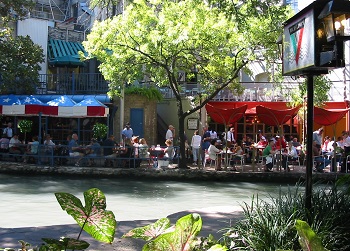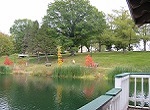Waterfront Redevelopment Usually Takes Years But Pays Rich Dividends
Last Reviewed: June 20, 2024
Waterfront redevelopment has exploded as a topic for inspired community development over the past 40 years. All of our ocean fronts, lakefronts, and riverfronts should have wonderful places to gather, live, work, play, walk, run, or simply watch the world go by. After all, when you go to Miami Beach, Baltimore, Boston, San Antonio, Amsterdam, Barcelona, or Venice, don't you like to hang out by those waterfronts? And don't you spend some money while you're there?

Waterways should be the focal points of our communities, instead of forgotten liabilities. Make them magnets for development instead of hangouts for anti-social behavior, or just mostly forsaken industrial remnants. Undertaken carefully, development can preserve and even enhance the natural functions of your waterway.
Even a small stream can attract investment, so don't underestimate that brook, creek, canal, coulee, bayou, or wash. It needs to be part of your place making strategy as a community.
Each city is unique in the role of its waterfront in its own history and in the larger system of the watersheds feeding into it. Your city can allow the waterfront to emerge as an
inspired unique place reflecting a part of its history. Waterfront redevelopment in its entirety usually takes decades, but important conversations with the community and some pilot projects can begin right away.
Do not be discouraged if you think your waterfront is too minor. Did you know the San Antonio River, which forms the basis for the Riverwalk shown above, really is a dinky little river? But what a great place to have dinner on a boat!
Incidentally some of you will need to start with the challenge of allowing a stream that has been encased in a concrete tube, or a concrete bottom at least, to naturalize. Removing a stream from a concrete drainage pipe, called daylighting, can create a new amenity for the community, but obviously it may well require some real estate acquisition as the stream finds a new path.
If you only have a concrete liner that engineers designed to make stormwater run off as rapidly as possible, the construction may be less daunting, but the real estate complications will likely be just as great. These projects are well worth the effort, especially when their financial costs do not become extreme.
Cleaning Up Your Waterfront
If you need to clean up your river, lake, stream, or beach, begin that process to make redevelopment options more attractive. Depending on the size of your water resource, and the degree of pollution or debris, that may be a process requiring many years, or stream clean-up could be a relatively orderly project to be repeated every six months to a year.
Clean-ups can be great ways to involve large numbers of people in your cause without requiring a major time commitment. As we detail elsewhere, they also are visually interesting and frequently attract positive media attention to help capture the imagination of the broader community.
Realize that the people upstream play a major role in whether your water is clean, so do what you can, but then begin to concentrate on the landward side of waterfront redevelopment. However, plug into any existing watershed planning efforts underway that would impact your body of water, and then you can hope to influence water quality that contributes to what you see in your locale.
Next tackle vacant and abandoned properties on the waterfront one by one. Persistence and patience are required in this work, since owners or their successors may not be local, may not be as motivated as you are, may be completely resistant to putting any money into the property, and may have unrealistic expectations about value if you try to purchase the real estate. Creating a media campaign regarding your target property may be helpful in building local interest and motivation to solve the problem. Try to find a few people or corporations who will adopt the really nasty industrial sites that still line some major riverfronts.
By the way we are not suggesting that obsolete industrial plants be demolished; to do so is to obliterate some of your local history, although it may be necessary in isolated cases when the dilapidation is really advanced. But study our suggestions for adaptive re-use to find some really creative possibilities for old buildings.
Along the way, you are very likely to need to learn something about brownfields, which are polluted sites or those suspected of being polluted. This work can quickly become technical, so communities dealing with long-vacant industrial uses must be prepared for employing a range of consultants and becoming acquainted with federal and state grant programs that are available to help. Some grant funding is available for site investigation and planning, however, so be sure to read more about that in the page linked above.
Despite all of the challenges presented by abandoned industrial sites, sometimes their cleanup is easier than working with an existing business that needs to remain operational while giving its exterior a facelift.
Railroads may own a good chunk of your riverfront or lakefront. If they aren't using them, consider claiming the lines as trails. If you have abandoned yards, try working closely with the railroad to turn those areas into parkland. Do not expect that you will resolve heavy rail conflicts within a couple of months; such projects often require many years, but the results are worth it.
After you tackle the worst eyesores and reach a natural pause in that work, begin to talk with existing prosperous industrial uses to enlist their cooperation in making the waterfront as handsome as possible and also as open for public use as possible. Here you need to consult intensively with economic development officials to see what can be done.
For example, if a prosperous industrial use relies on outdoor storage of mounds of supplies or ground-up materials for recycling, your economic development people may be able to encourage and incentivize the business to relocate or screen stockpiles, or just consolidate their junk! Keep in mind that the stockpiles and outdoor storage yards probably are hazardous to water quality as well.
At this point it becomes worthwhile and indeed essential to formulate a plan for your waterfront, if you have not done so already. It should be a public process following a community planning model. This begins with a lengthy and often difficult conversation about the ideal future of the waterfront and how it should evolve over the next 40 years. We do recommend a planning horizon of more than the typical five or twenty years, as waterfronts usually involve long-range business decision-making.
Some businesses will need to remain indefinitely either because their capital investment and dependence on water transportation or railroads is so high, or perhaps because the uses are inherently water-dependent, such as marinas, docks, or boat construction. Eventually some of those businesses may disappear, but be respectful and realistic as you proceed.
If you have navigation on your river or lake, work with the authorities that govern that navigation to determine what is realistic. Our experience is that navigation actually adds visual interest to your river or lake, so don't start with the assumption that you want to shut it down. Usually you don't, unless there is an intractable pollution issue. This should not be the case in Europe, the U.S., and other countries where environmental regulation is somewhat stringent.
Even if it takes 40 years, waterfront redevelopment is worth it. Like other community improvement initiatives, waterfront action does not require 100 percent success to provide a wonderful public amenity, improved water quality, and new reasons to invest in your community.
Trails, Corridors, and Green Spaces Along the Water
Meanwhile, you need to start reclaiming access for the public to its waterfront. If an active industry actually uses the river or lake in some phase of its process, how can you go around it while you're creating a great waterfront redevelopment? Can a part of its campus be opened to public use as a trail?
Speaking of trails, waterfronts are ideal locations. If there's no trail system along your river or lake, start on that idea today, using any available public right-of-way. If it makes sense to build a small section of trail, it will contribute to the goal of being perceived as a walkable community and a bikeable community as well.
Trail or corridor development requires fresh attention to the aesthetic concerns we only touched on briefly above. If the nearby buildings are ugly, maybe you can fence them off, screen them with trees, paint a mural on one, or simply paint them. Even with these measures, it's essential that the waterfront between the industrial plant and the river or lake feel safe and accessible to the public as much as possible. Trails usually need to be visible from beyond the immediate waterfront to make users feel safe, but much depends on the site layouts and topography in your area. Your waterfront redevelopment likely will occur in several major chunks, so make the old development as pretty as possible.
This isn't simply a matter of aesthetic sensibility. Trails and promenades are a real benefit to a community. They add to the exercise options and quality of life that the "creative class" of young people and many healthy older folks seek. In addition, there's a more direct economic benefit as trail users buy water, refreshments, or gear, and bring their friends and family who also purchase items from waterfront oriented businesses.
Beyond linear trails and walkways, you need to think about whether some area can be temporarily or permanently converted into great green space. Green spaces offer the advantage of being possible to design in almost any shape or size, but if you go this route, be sure to engage a really talented landscape designer who will be sensitive to environmental values to be preserved or created in a waterfront park.
Even if you are not able to obtain site control to create a new green space as such, smaller opportunities for access to the water and for catching a glimpse of the water are critical for building the kind of public access to the waterfront that every citizen deserves. Ask yourself questions such as: Is there a high point offering a view of your river or lake or ocean? Where is it? Is it accessible to the public? Can you make it a viewing platform? Can we identify a 10 or 15 foot wide strip of land that would allow the public to go down to the water when otherwise they would be blocked by private property?
Waterfront Views Should Create Prime Real Estate
This direct economic benefit begins to be possible when you figure out how to create long views of your river or lake. We think people are wired to appreciate a view out over the water, just as there seems to be an innate positive response to viewing the horizon. Therefore, it follows that people will pay a premium for an office, condo, or restaurant meal in a waterfront redevelopment.
You may have vacant property along the water ripe for developers to acquire, or your work with vacant industrial properties may yield a new site for sale. Intense public sector help may be needed when there are brownfield or title issues, and when there is a need for a pre-development property owner.
Ideally this infill development stage occurs after the community planning process has been completed, or at least after a preliminary round of consideration public input. The public entity that will take the lead on waterfront development should be identified as a plan is being prepared, and that entity probably will be the one issuing a Request for Proposals or perhaps acting itself as a developer.
Many times your city will need to amend its development regulations to deal specifically with waterfront opportunities. Changes in zoning regulations and the zoning map may be necessary.
For example, does your market allow development of tall residential, commercial, or mixed-use buildings? If so, make the strongest rules you can to assure that new development takes advantage of the waterfront vista. You might create a waterfront zoning district, or a waterfront redevelopment overlay zoning district that adds regulations to a mapped portion of an existing zoning district. This could require a percentage of the building front looking over the water to contain windows. You also may require easements alongside of buildings that allow public access to the water.
Creating Visual Unity and Vitality in Waterfront Redevelopment
Lastly, remember that your goal is to create a strong sense of place for your waterfront redevelopment project. Although absolutely every waterfront has plenty of potential in this regard, it's up to you to see that the potential becomes a reality. Do not copy someone else's waterfront, because your unique history and story becomes a golden opportunity for interpretation and education.
Attempt visual continuity of some type along the waterfront. Do this with special pavers, sidewalks, wayfinding signage, banners, flags, and an easy-to-follow street pattern that leads directly to the heart of your town or city. This kind of branding of the waterfront can occur well before property ownership issues have been resolved.
Keep the street interesting and colorful, even celebratory. There is no reason to be somber along a glorious stretch of river. The principles are the same as good streetscape. If you have commercial portions of the waterfront, such as a restaurant district, use the principles of commercial district revitalization, even if your conglomeration of restaurants is rather new. Like any space that should be pedestrian-friendly, try to energize any long stretches where there are no pedestrian destinations (stores, restaurants, and so forth) with public plazas, seating areas, kiosks, street vendors or performers, public art (even if borrowed from sculptors), or something else of interest.
Keep parking lots away from the riverfront itself, due to polluted stormwater runoff considerations, but make sure there is ample parking and/or transit. Take advantage of the waterfront for summer festivals, which means that you need an outdoor gathering space of considerable proportion in comparison with the size of your community. Start preparing one, and the programming usually will follow, especially if you make the rental rules and procedures easy and inexpensive.
Just don't leave it to chance. The municipal government itself probably needs to start the ball rolling with some programming, by which we mean concerts, runs, walks, boat parades, a street or trail painting contest, a community picnic, water festival, mural painting if you have seawalls, or whatever else your physical space will allow.
In sum, your principles should include:
- Start directing people's attention to your waterfront, not away from it. A simple social media awareness campaign, along with basic signage or banners, can start this shift in public awareness. This is true even if your "waterfront" is a minor stream.
- Do a long-range plan for the waterfront redevelopment area. Engage with all of the stakeholders, including current property owners, businesses, environmental groups, developers, nearby residents, and lastly the public at large.
- Clean up your water, as well as your vacant, abandoned, or unsightly buildings and outdoor storage.
- Screen what you can't clean.
- What Mother Nature has created belongs to all of us. Don't fence it off from the public.
- Create destinations and attractions, adaptive re-uses, and infill development steadily as you respond alertly to opportunities.
To dig in more, see the Waterfront Center site in America, or websites of other national organizations, such as the Canal River Trust in the U.K.
Read More in Our Related Pages
- Making and Keeping a Good Community >
- Community Challenges, Common Topics & Concepts >
- Redevelopment > Waterfront Redevelopment
Join GOOD COMMUNITY PLUS, which provides you monthly with short features or tips about timely topics for neighborhoods, towns and cities, community organizations, and rural or small town environments. Unsubscribe any time. Give it a try.




